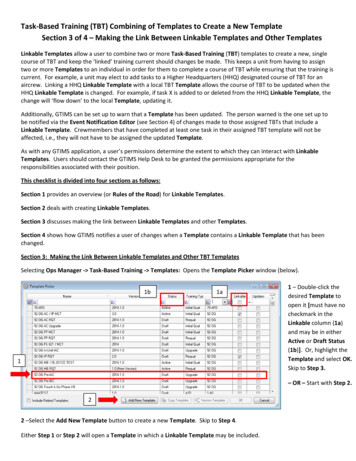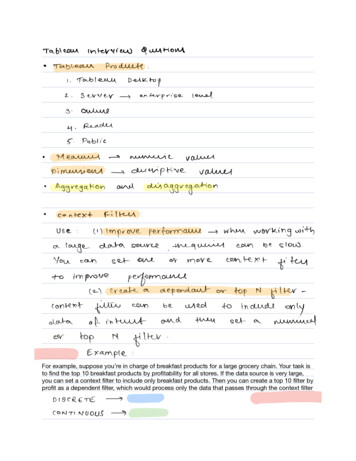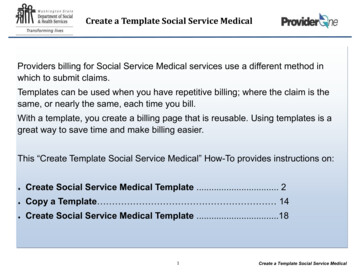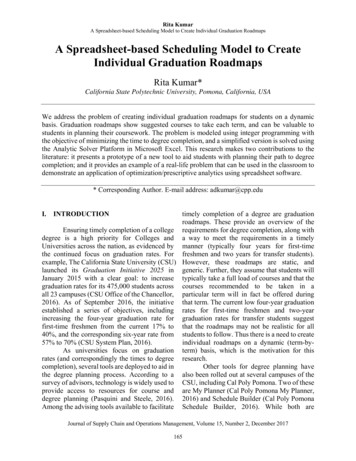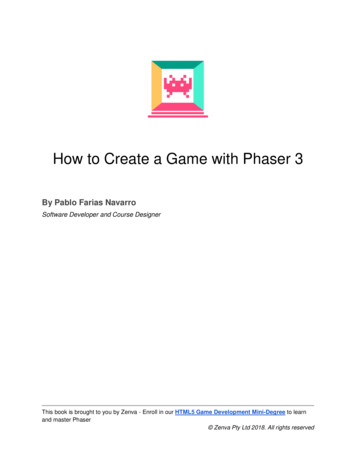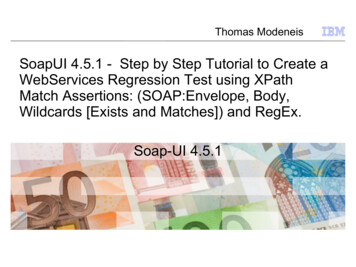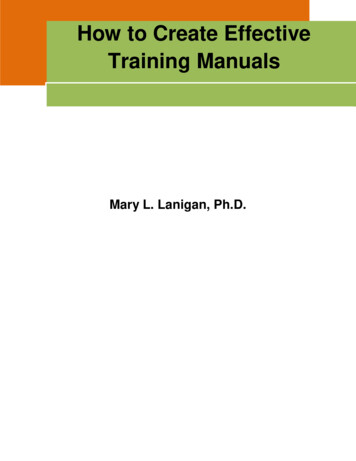
Transcription
How to Create EffectiveTraining ManualsMary L. Lanigan, Ph.D.
How to Create EffectiveTraining ManualsMary L. Lanigan, Ph.D.Third House, Inc.Tinley Park, Illinois 604771
How to Create Effective Training ManualsCopyright 2010 by Third House Inc.Third House Inc.P.O. Box 1245Tinley Park, Illinois 60477All rights reserved. No part of this manual may be photocopied or reproduced in anyform without written permission from the publisher. Moreover, no part of this publicationcan be stored in a retrieval system, transmitted by any means, or recorded or otherwise,without written permission from the publisher.Limits of Liability and Disclaimer of WarrantyWhile every precaution has been taken in preparing this manual, including research,development, and testing, the Publisher and Author assume no responsibility for errorsor omissions. No liability is assumed by either Publisher or Author for damages resultingin the use of this information.Printed in the United States of America2
Table of ckground Information6Step 1: Complete a Front-end Analysis6Step 2: Divide the Content into Modules6Step 3: Select a Style Manual7Creating the Training Manual8Chunk Material and use Transitions8Writing is Easy to Read11Leave White Space11Use Images11Use Bullets11Visually Appealing12Provide Practice12Edit the Draft Training Manual13Finalize the Training Manual13Front Contents13Back 3
WelcomeThese guidelines have been written for a training context in which a training manual willbe the main delivery source for the educational experience. The manual will neithercompliment a stand-up trainer nor will it be downloaded from an Internet trainingsession. Instead, this training manual will be used as a self-study tool. While most of theguidelines also hold true for a training manual that compliments a stand-up or Internetdelivered training, the focus of these guidelines is on a self-study manual. For moreinformation about an instructor-led manual, see the Appendix.Pre-requisite SkillsThis manual is written for an audience that already is familiar with front-end analyses.You should know, at the very least, how to carry out a task listing and how to constructa structured lesson. You should also have the skills to do screen captures, usabilitytesting, and creating documents in Word software.4
IntroductionIntroductionThe purpose of this manual is to guide instructional designers on how to create effectivetraining manuals. The benefit of learning this information is to create professionallooking educational tools that will serve your clients well. It is important to implement theinformation within this manual in order move your clients to optimal levels ofperformances.ObjectivesAt the end of this lesson, you will be able to: Write a training manual; Edit a training manual; and, Appropriately bind a training manual.OutlineComplete a Front-end AnalysisDivide the Contents into ModulesSelect a Style ManualCreating a Training ManualEdit a Training ManualBind a Training Manual5
Steps to CreatingBackgroundEffectiveInformationTraining ManualsThere are three steps you should take before composing your training manual. Thesesteps are similar to designing any other performance improvement intervention.Step 1: Complete a Front-end AnalysisBefore writing a training manual, you should have completed some type of front-endanalysis, including task analysis. By doing so, you will have created, at the very least, atask listing of terminal and enabling objectives for the cognitive and behavioral tasksyou plan to teach within the training manual. You should also have a list of performanceobjectives that manifested from the task listing. The task listing and performanceobjectives will guide the outline of your training manual. The outline should follow thetask listing in the sense that all pre-requisite skills should be presented before moreadvanced skills.Step 2: Divide the Content of Your Training into Modules or ChaptersAfter outlining the content domain of your training, divide the content of your training intomodules or chapters. Each module will then be set-up as a structured lesson.6
Step 3: Select a Style Manual and Prepare a Style Sheet to EnsureConsistencyThere are a few style manuals to select from such as the AmericanPsychological Association (APA), the Modern Language Association (MLA),and the Chicago Manual of Style. All three of these manuals offer extensiveguidelines on how to present information, including how to cite rights andpermission, grammar and usage, punctuation, spelling, names, numbers,foreign language, quotes, illustrations, tables, math, abbreviations,references, indexes, and more.A style sheet helps the writer ensure that the training manual looks consistent. For example, ifthe main headings are Arial, 14 point font and the sub-headings are Arial 12 point font, then allmain and sub-headings should follow suit. The manual would look less professional if some ofthe headings were Arial 14 while others were Times New Roman 12, or if the sub-headingswere listed in various font sizes from 10 to 18.Besides listing heading sizes, the style sheet notes the rules the writers and editors will follow.For example, if there is special punctuation used or unusual terminology, then the style sheetwould note the guidelines to follow for these cases.7
Creating the Training ManualStep 1: Write the draft of the Training ManualWhen writing your draft manual, implement the following tips.A. Chunk material into shorter; albeit logical, sections. Connect sections withtransitions.Trainees will be overwhelmed by huge amounts of text group together. To reduce theiranxiety and engage them in your training materials, create shorter paragraphs. Placethe paragraphs in logical order. As you present your information, you want to chunkyour ideas into units or what would be in writing, a paragraph. A paragraph typicallypossesses four elements.1. A main idea.2. An explanation of the main idea, i.e., the presenter’s rationale.3. Examples and/or non-examples to illustrate the explanation.4. A completion of the idea and transition into the next topic.EXAMPLEInnovative Practices for Needs Assessors*Needs assessment is one of the most important processes to implement beforeactivating any intervention. Surveys, focus groups and interviews are the traditionalassessment apparatus used to uncover performance gaps. To utilize these toolsoptimally, blind obedience to what has been done in the past can sabotage presentobjectives; and instead, implementing contemporary ideas is paramount. Thispresentation introduces innovative practices which were executed during a needsassessment to determine if building a health center was essential to an Illinoiscommunity were loss school days and emergency room visits were costly.8
In additional to presenting ideas in cohesive chunks, incorporating effective transitionalstatements will help your audience better understand how you are moving from oneidea to the next. Transitions are frequently made up of transitional devices.A transitional device cues the listeners to a connection between thoughts. Below aresome examples.Transition DevicesExample Words UsedAdditionand, in addition to, furthermore, moreover,besides, too, also, another, equally important,first, second, etc., again, further, next, likewise,similarly, in the same wayIllustrationthus, for example, for instance, namely, toillustrate, in other words, in particular,specifically, such asEmphasisabove all, of course, certainly, surely, in fact,really, in truth, again, besides, also,furthermore, in additionExamplesfor example, for instance, to illustrate, thus, inother words, as an illustration, in particularSuggestionfor this purpose, to this end, with this in mind,thereforeSummarytherefore, finally, consequently, thus, inconclusion, in brief, as a result9
If you are doing a procedural manual like this one, then make sure the steps are inlogical order. In other words, you want to define terms and concepts before you requirethe trainees to analyze or apply steps. Use examples frequently to explain what you arecommunicating. Mix up you examples by using illustrations, case studies, games, etc.You may wish to incorporate an action table as illustrated below.When describing procedures make sure you don’t leave out steps that may seem likecommon sense to you but may not be to the novice user. If you have successfullycompleted a front-end analysis, then you should have a good idea on how much yourlearners know as well as what they don’t know. Moreover, encourage trainees to thinkabout their own past experiences in order to aid them in engaging in and applying thenew knowledge presented in the training manual.10
B. Make sure the writing is easy to read. Avoid jargon when possible unless youhave defined those unusual terms before-hand. Use the active voice. Beconsistent in tone and style of writing.EXAMPLEActive Voice: Sally wrote a training manualPassive Voice: The training manual was written by Sally.C. Leave white spaces between chunks of ideas and other logical groupings.White space makes the material look less intimidating.D. Use images to enhance the writing. You know the saying, “A picture is worth athousand words.” Use images that further enhance your message.E. Use bullets to offset text. Using bullet points helps the readers see importantinformation.11
F. Create a visually appealing manual. Lay the pages out in a manner that attracts the reader to themanual. Select font styles and sizes that are easy to read. Use chapter and/or module dividers, especially in a color thatoffsets the pages.G. Provide practices and feedback throughout. A quality training manual alwaysprovides the trainees with a number of exercises and/or practices of thematerials. Along with practice is feedback. The trainees need communicationmechanisms that tell them how well they are doing.Practice Exercise for Step OneIn the Appendix, you will find a quiz to test you on the informationpresented so far.12
Step 2: Edit the Draft Training Manual and Complete Usability TestingEdit the draft manual to make sure the contents are accurate, clear, andcomprehensive. After editing your manual a number of times, next test the materials onpeople who are like your trainees. Complete usability tests to make sure the trainingmanual is fully functional.Step 3: Finalize the Training Manual by Adding the Front ContentsWrite the introductory materials for the training manual such as the title page, publisherand copyright page, things to note page, and table of contents.Title page: State the title, sub-title if the manual has one, and author’s name.You may also wish to state the company and organizational location on this page.13
Publisher and Copyright page: State the manual title, the copyright symbol along withthe publisher or author’s name (depending on who owns the copyright), the company’sname and address as well as the URL if appropriate.You want to include a paragraph reserving your rights. You need to stipulate whatrights, if any, you wish to reserve.Indicate the liability limits, if any. Also, indicate any warranties or disclaimers.If there are trademarks used, then you want to indicate those. You want to list thecompany name and the trademarks they hold.You may also wish to indicate where the manual is printed. Moreover, if you have anInternational Standard Book Number, then indicate the ISBN number.14
Table of Contents: You want to include a detailed Table of Contents that includeschapter headings, main headings, and sub-headings.Things to Note or Preface: There are a number of items you may wish to include inthis page. Here are some examples.A. What is the purpose of the manual?B. What equipment and/or materials are needed beside the manual to complete thetraining?C. Any pre-requisite knowledge and skills necessary to complete the manual. Thismight include a glossary of terms, if needed.D. List any obstacles a trainee might uncover and how to overcome these problems.If you are teaching highly technical skills such as providing software skills, thenyou may have an extensive trouble-shooting section in the back of the manual. Ifyou provide such an addendum, then note that in the preface page so thetrainees know where to look for this information.15
E. Encourage trainees to follow the order of the manual in order not to miss any prerequisite skills.F. If you have a help resource person, then tell the trainees how to contact him orher.Practice Exercise for Step ThreeAnswer the questions below. To see if your answers are correct, go to the Appendix.1. Name four pages that come before the main body of the training manual?2. Besides the copyright and author or publisher information, name two additionalitems that might appear on the Copyright page.3. Name six items that might appear in the Preface or Things to Know page.16
Step 4: Finalize the Training Manual by Adding the Back ContentsWrite the back contents for your manual. The contents in the back of the manualinclude: Addendum; References; and Index. You need to decide if you wish to haveindividual addendum and reference sections following each module, or if you want onelarge addendum and reference section for the entire manual.Appendix or Addendum: Each Addendum section is unique. See the Appendix in thismanual to see an example.References: The reference section should be designed and written following theguidelines of your style manual. For example, if you use the APA manual, then yourreferences would look something like the example below.17
Index: A detailed index helps trainees find information quickly. The index is optionaldepending on how detailed the manual is. There is also a cost factor involved, in that,indexing takes time and money. Therefore, consider if an index is cost-effective to havewithin your manual or not.18
Step 4: Bind the Training Manual and Attaching Ancillary ItemsYou want to bind the training manual in a way that is most suitable for the user. Forexample, if the user needs to position the manual flat on a table while working on acomputer, then perhaps a spiral bound manual might be the best binding.On the other hand, if the trainee is going to refer back to the manual frequently, then thespiral bound manual may be prone to rips and tears. If durability is more important thanbeing able to lay the book flat, then a book binding may be more appropriate.A book-type binding doesn’t allow for quick updates or changes. Therefore, if you needa training manual that can be pulled apart and new information added, then a three-ringbinder may be the best option.19
In addition to the binding, you alsowant to consider if the training manualis going to house other things such asCDs, job aids, etc. If you are includinga CD with the manual, determine howyou will house the CD. For example,do you want to buy stick on CDholders to attach to the back of themanual?Perhaps, you might buy a CD holderthat has a three ring attachment. Or,you might wish to consider if you areincluding additional information suchas job aids or maps or other likeproducts, then you need to considerhow the training manual will housethose materials.Finally, consider any information thatmight be needed on the back coverof the training manual. A summary ofthe books content, highlights, theISBN number, and price are oftenlisted on the back cover.20
SummaryIn this lesson you learned the three pre-requisite steps to complete before creating yourtraining manual. You learned when drafting a training manual to make sure the materialis: chunked; connected with transitions; easy to read; incorporates white spaces; uses images; uses bullets; is visually appealing; and, provides practices and feedback.You learned when finalizing the training manual, you need to complete usability testsbefore adding the remaining front and back pages. You also learned about the elementsrequired in the front and back of the manual. Lastly, you learned how to bind themanual.21
Appendix22
Training Manuals used with a Live InstructorManuals that accompany a live training are not necessarily as detailed as self-studymanuals because trainers are there to offer verbal guidance. Unlike a self-study manualthat needs to communicate to trainees what equipment and materials are needed tocomplete the lessons, a teacher-led training manual doesn’t need such informationbecause the trainer will provide these things to the students. Likewise, communicationgaps can be filled by a trainer if something is unclear in a training manual thataccompanies a live training; whereas in a self-study piece, the manual has to anticipatethese communication gaps and close them.Instructional designers creating training manuals that accompany live instruction, unlikeself-study, have to strategize on how to integrate the training manual materials with thelive instruction. The two have to work together, not necessarily repeat or mimic eachother. This guideline is also true for training manuals that are created as a complimentto some type of computer-based-training workshop, no matter if it is delivered on theInternet or CD.Instructor ManualIf you are creating a live training, then more than likely you will also need to write aninstructor’s manual in addition to the students’ manuals. The instructor’s manual will besimilar to the students’ manual but it will also contain additional information.1.While some script may be necessary to give the instructor a feel for what youwant them to say, don’t expect them to communicate everything word for word.Instead they will more likely paraphrase what needs to be communicated so theysound natural while delivering the training information.2.Instructors typically walk around the training room, use technologies, and othervisual aids as they deliver instruction. Therefore, the instructor’s manual has tobe mobile and easy to read with a quick glance. Large print inside the manual willhelp achieve this goal. You may also wish to highlight information that needs tobe stressed. In some cases a text box containing questions and answers mighthelp offset the materials.3.A critical feature to any instructor’s manual is a timing device. There is the overalltime for the training. There is the breakdown of time for each module. And thereare the minutes it takes to get through each section of each module, including allpresentation segments, exercises, debriefs, breaks, lunch breaks, etc. Theinstructor’s manual highlights these times.23
4.Additionally, the instructor’s manual should also indicate the following:o Classroom layouto Location of rest rooms, library, computer-labs, eating spots, etc.o All test and answers; exercises and supplies needed to carry out theexercise; all answer keys, etc.o Any helpful hints and extra tidbits the instructor might use.o PowerPoint overheads and/or handouts.24
Practice Exercise for Step OneWrite the correct answer to each question.1. What are the four elements to a paragraph?2. Name two transitional devices?3. What is the table called that lists steps, actions, and examples?4. True or False: You don’t want too much white space in order that the manualdoesn’t become too long.5. What technique helps the reader see important information easily?Answers are listed at the bottom of the page.Practice Exercise Answers for Step Three1. Name four pages that come before the main body of the training manual?Title; Copyright; Table of Contents; and Preface or Things to Know2. Besides the copyright and author or publisher information, name two additionalitems that might appear on the Copyright page.Rights reserved; Limits of Liability; W arranties; ISBN number3. Name six items that might appear in the Preface or Things to Know page.Manual purpose; Equipment; Pre-requisite knowledge; Possible obstacles;Emphasis on fo
session. Instead, this training manual will be used as a self-study tool. While most of the guidelines also hold true for a training manual that compliments a stand-up or Internet delivered training, the focus of these guidelines is on a self-study manual. For more information about an instructor-led manual, see the Appendix. Pre-requisite SkillsFile Size: 1MB
